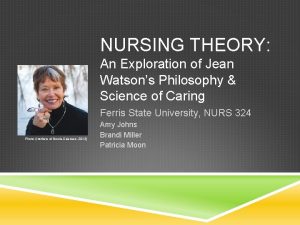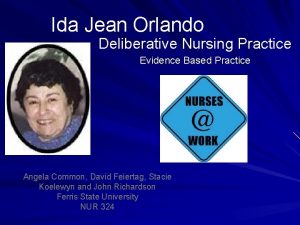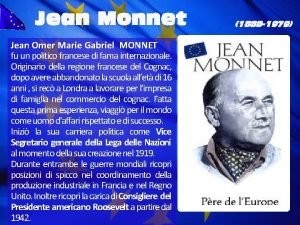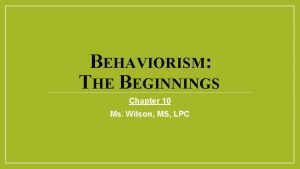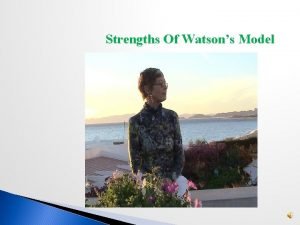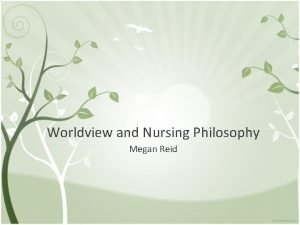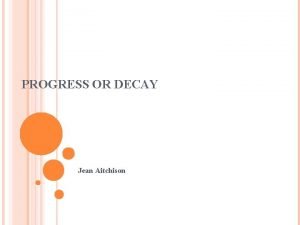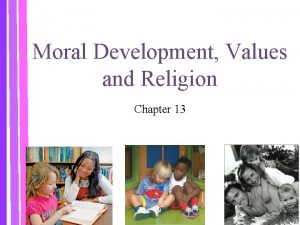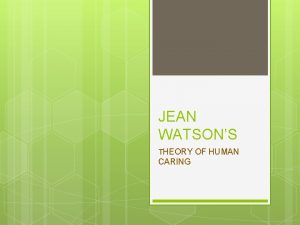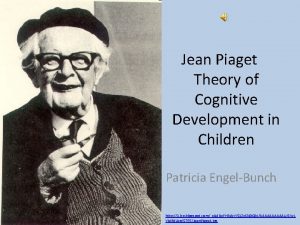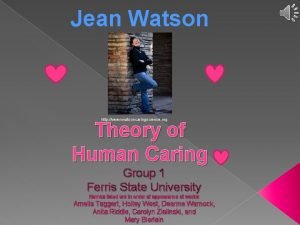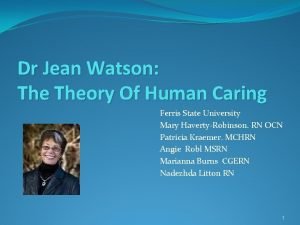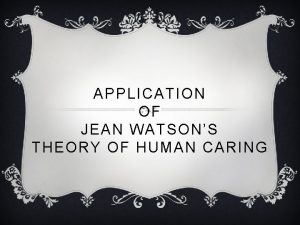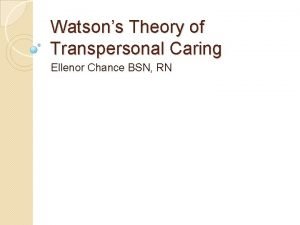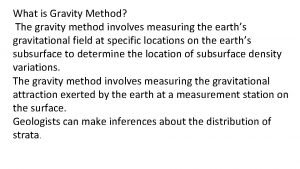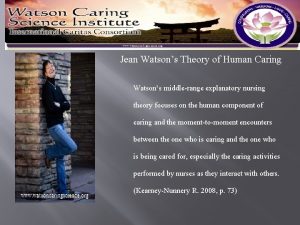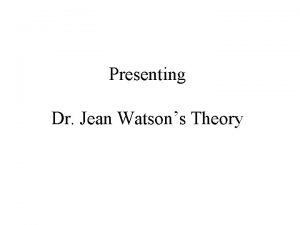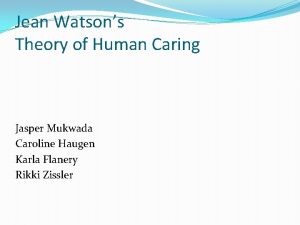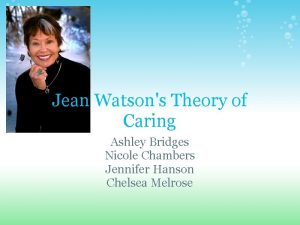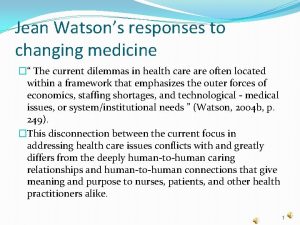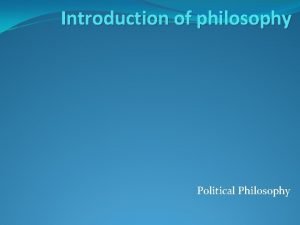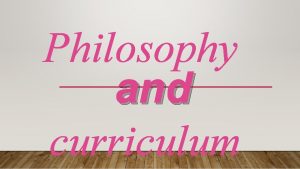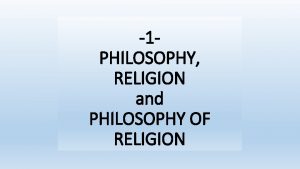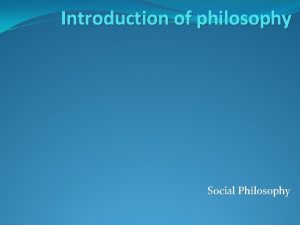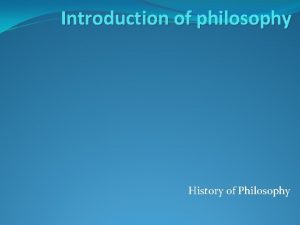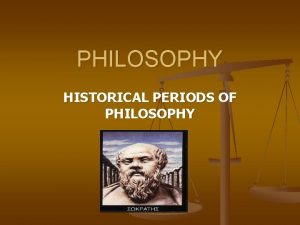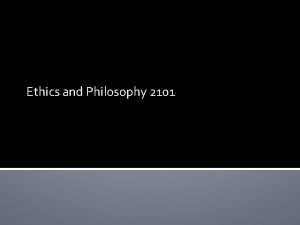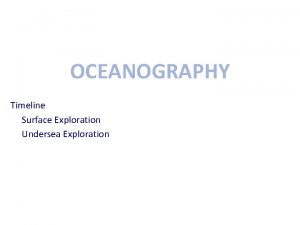NURSING THEORY An Exploration of Jean Watsons Philosophy








































- Slides: 40

NURSING THEORY: An Exploration of Jean Watson’s Philosophy & Science of Caring Ferris State University, NURS 324 Photo: (Institute of Noetic Sciences, 2013) Amy Johns Brandi Miller Patricia Moon

WHAT IS NURSING THEORY? An organized, systematic group of concepts, definitions, and statements that describe nursing phenomena and can be used to predict or explain outcomes (Black, 2011) (Current Nursing, 2012) Photo: (Fellowship of the Minds, n. d. )

WHY IS NURSING THEORY IMPORTANT? Develops and clarifies the body of nursing knowledge Enhances the status of nursing as both an academic discipline and a profession Improves the quality of patient care Enhances reasoning, critical thinking, and decision making in nursing practice (Tomey & Alligood, 2006)

THEORY COMPONENTS Theory Components Contributions to the Theory CONCEPTS & DEFINITIONS Concepts Describe and classify phenomena of interest Theoretical definitions of concepts Establish clear meaning Operational definitions of concepts Provide for empirical measurement RELATIONAL STATEMENTS Theoretical statements Relate concepts to one another; permit analysis Operational statements Relate concepts to measurements LINKAGES & ORDERING Linkages of theoretical statements Provide rationale of why theoretical statements are linked; add plausibility Linkages of operational statements Provide rationale for how measurement variables are linked; permit testability Organization of concepts and definitions into primitive and derived terms Eliminates overlap Organization of statements and linkages into premises and derived hypotheses and equations Eliminates inconsistency (Tomey & Alligood, 2006, p. 36)

Philosophies Conceptual Models Theories Middle Range Nursing Theories TYPES OF NURSING THEORETICAL WORKS

PHILOSOPHIES Clarify values and provide a broad understanding and general view of nursing Represent early works that predate theory era and later works of a philosophical nature Contribute to nursing knowledge as a basis for professional scholarship leading to theory development Examples: Florence Nightingale: Modern Nursing Jean Watson: Philosophy and Science of Caring Patricia Benner: From Novice to Expert Florence Nightingale (Black, 2011) (Tomey & Alligood, 2006) Photo: (Wikipedia, n. d. )

CONCEPTUAL MODELS Broad, conceptual structures that describe the nature of nursing concepts and address the broad metaparadigm Include concepts, definitions, and propositions, and their interrelationships to form an organized perspective for viewing nursing phenomena Less abstract and more formalized than philosophies More abstract than theories; used to build theories Examples: Martha E. Rogers: Unitary Human Beings Dorothea E. Orem: Self-Care Deficit Theory of Nursing Imogene King: Interacting Systems Framework and Theory of Goal Attainment (Black, 2011) (Tomey & Alligood, 2006)

THEORIES Grand nursing theories are abstract conceptual structures that are derived from nursing models and propose outcomes based on use and application of the model Theories describe, explain, control or predict nursing phenomena Both grand nursing theories and theories provide focus for development of middle range theories Examples: Madeleine Leininger: Culture Care Theory of Diversity and Universality Ida Jean Orlando (Pelletier): Nursing Process Theory Nola J. Pender: Health Promotion Model Madeleine Leininger Photo: (Healio, 2013) (Black, 2011) (Tomey & Alligood, 2006)

MIDDLE RANGE NURSING THEORIES Describe nursing phenomena, explain relationships between phenomena, and predict the effects of one phenomena on another within a limited dimension of nursing practice Propose specific outcomes with a narrow nursing focus Make connections between grand theories and nursing practice Examples: Ramona T. Mercer: Maternal Role Attainment – Becoming a Mother Carolyn L. Wiener and Marylin J. Dodd: Theory of Illness Trajectory Phil Barker: Tidal Model of Mental Health Recovery Phil Barker Photo: (Nursing Times. net, 2013) (Black, 2011) (Tomey & Alligood, 2006)

JEAN WATSON'S PHILOSOPHY & SCIENCE OF CARING Nursing is a human science based on values and concerned with health promotion, health restoration, and illness prevention Caring is central to nursing and is an intentional value that manifests itself in concrete acts Nursing practice is based on holistic carative factors; it contrasts with medicine which is based on curative factors The nurse and patient change together as they participate in the transpersonal caring process (Black, 2011) (Mc. Cance, Mc. Kenna, & Boore, 1999) (Tomey & Alligood, 2006)

CREDENTIALS & BACKGROUND Born and raised in the Appalachian Mountains of West Virginia Graduated from the Lewis Gale School of Nursing Moved to Colorado in 1961; attended University of Colorado Master’s in Psychiatric-Mental Health Nursing; Doctorate in Educational Psychology and Counseling Joined University of Colorado School of Nursing faculty and became Director of Nursing Ph. D program before traveling on sabbatical Dean of University of Colorado School of Nursing Distinguished Professor of Nursing; Murchinson-Scoville Endowed Chair at University of Colorado School of Nursing (Tomey & Alligood, 2006)

THEORETICAL SOURCES Nursing knowledge combined with theories from Nightingale, Henderson, Leininger, Maslow, Erickson, and Whitehead Guidance from feminist theory, quantum physics, traditional wisdom, perennial philosophy, sciences, and humanities States “my early work emerged from my own values, beliefs, and perceptions about personhood, life, health, and healing”(Tomey & Alligood, 2006, p. 94) Emphasis on congruence, empathy and warmth credited to transpersonal psychology and Carl Rogers Believes nurses need solid background in liberal arts and humanities to develop personal growth and thinking skills (Tomey & Alligood, 2006)

Watson’s Ten Carative Factors MAJOR CONCEPTS & DEFINITIONS Photo: (Watson Caring Science Institute, n. d. )

FORMATION OF A HUMANISTICALTRUISTIC SYSTEM OF VALUES Definition: Practice of loving-kindness within the context of caring consciousness. “We can become part of a global vision of health and human transformation to help purify the toxins and poisons; the negativity of violence, abuse, war; the noncaring and disregard for the humanenvironment-universe connection for self and all living things. ” (Watson, 2008, location 847) Use in Nursing Practice: “Be the work” and be a living model of caring and altruistic values Cultivate a mindset of gratitude, loving kindness and compassion Develop equanimity, an inner state of balance and a noninterference of what is (Watson, 2008)

INSTILLATION OF FAITH-HOPE Definition: Being authentically present and enabling and sustaining the deep belief system and subjective life-world of self and one being cared for. “We cannot ignore the importance of hope and faith and the role they play in people’s lives, especially when faced with the unknowns, mysteries, and crises of illness, pain, loss, stress, despair, grief, trauma, death” (Watson, 2008, location 1098) “Field of Hope” by Kirsten Bailey (2010) Use in Nursing Practice: In times when there is no concrete, tangible modality to be done, an expression of faith and hope from us can allow another to access this part of themselves Attend and support the balance of mind-body-spirit and develop a holistic sense of caring (Adventist Hinsdale Hospital, 2011) (Watson, 2008)

CULTIVATION OF SENSITIVITY TO SELF & OTHERS Definition: Cultivation of one’s own spiritual practices and transpersonal self going beyond the ego self. “…the source of maturity, reflection, insight and mindfulness for developing an evolved consciousness is within. ” (Watson, 2008, location 1174) Use in Nursing Practice: Cultivate one’s own spiritual growth, insight, mindfulness in order to be sensitive to self and others Acceptance and cultivation of these qualities fosters spiritual development and is the basis for transpersonal connections (Watson, 2008)

DEVELOPMENT OF HELPING-TRUST RELATIONSHIP Definition: Developing and sustaining a helping, trusting, authentic, caring relationship. “It is life-giving, human-to-human, spirit-to-spirit connection…” (Watson, 2008, location 1233) Use in Nursing Practice: Base our practice on respect, trust, love, and personcentered relationships, and build on previous carative factors of self discovery and self knowledge Relationship-centered care focused on layers of relationships: Practitioner to self Practitioner to patient Practitioner to community Practitioner to practitioner (Watson, 2008) “Two Sisters (The Meeting)” by Pablo Picasso (1902)

PROMOTION & ACCEPTANCE OF THE EXPRESSION OF POSITIVE & NEGATIVE FEELINGS Definition: Being present to, and supporting of, the expression of positive and negative feelings as a connection with deeper spirit and self and the one-being-cared for. “When one is able to hold the tears or fears of another without being threatened or turning away, that is an act of healing and caring. ” (Watson, 2008, location 1615) Use in Nursing Practice: Allow a person’s feelings, honor and accept them, both positive and negative This allowance may enable a person to move through and release negative feelings on the way to growth This discovery of an unknown part of self will result in new dimensions of the knowledge of self and of relationships (Watson, 2008)

SYSTEMATIC USE OF THE SCIENTIFIC PROBLEM SOLVING METHOD FOR DECISION MAKING Definition: Creative use of self and all ways of knowing as part of the caring process; to engage in the artistry of caring-healing practices. “Information is not knowledge; knowledge alone does not mean understanding; even understanding, in isolation, does not necessarily include insight, reflection, and wisdom. ” (Watson, 2008, location 1735) Use in Nursing Practice: The nursing process is a guide for nurses’ decision making but is linear and does not allow for the complexity of the human condition Make communication a tool on equal footing with evidence-based practices Acknowledge that computerized documentation systems are not developed to quantify or reflect the artistry of the carative factors (Watson, 2008) (Watson, 2009)

PROMOTION OF INTERPERSONAL TEACHING-LEARNING Definition: Engaging in genuine teaching-learning experience that attends to unity of being and meaning, attempting to stay within other’s frame of reference. “…the person becomes his or her own best problem solver; the individual is his or her own best source for finding unique creative solutions for meeting goals and a vision for change. ” (Watson, 2008, location 2047) “…the nurse becomes more of a sojourner along with the other, helping the other find new energy, time, and ways to excel by working from the inside out, connecting with his or her inner spirit…” (Watson, 2008, location 2047) Use in Nursing Practice: Cultivate sensitivity to the whole person; accurately detect another’s feelings, thoughts, reactions and mood to capture a teaching moment and connect with the learner Foster in the learner the ability to determine their own needs and self-care (Watson, 2008)

PROVISION FOR SUPPORTIVE, PROTECTIVE & CORRECTIVE MENTAL, PHYSICAL, SOCIOCULTURAL & SPIRITUAL ENVIRONMENT Definition: Creating healing environment at all levels (physical as well as nonphysical, subtle environment of energy and consciousness, whereby wholeness, beauty, comfort, dignity and peace are potentiated). “What we hold in our heart matters. ” (Watson, 2008, location 2241) Use in Nursing Practice: Attend to the physical and the environmental to facilitate peace and healing Attend to the environment beyond the most obvious to include those of energy and consciousness Free your mind and practice all the carative factors before entering the room (Watson, 2008)

ASSISTANCE WITH GRATIFICATION OF HUMAN NEEDS Definition: Assisting with basic needs, with an intentional caring consciousness, administering “human care essentials, ” which potentiate alignment of mind-body-spirit, wholeness, and unity of being in all aspects of care. Use in Nursing Practice: Human care essentials or basic human needs are recognized: Food and Fluid Toileting/Bathing/Personal Appearance Ventilation Activity/Inactivity Sexuality/Creativity/Intimacy/Loving Achievement: Expressivity/Work/Contributing Beyond Self Need for Affiliation: Belonging/Family/Social Relations/Culture Need for Self-Actualization/Spiritual Growth “Girl at Mirror” by Norman Rockwell (1954) (Watson, 2008)

ALLOWANCE FOR EXISTENTIAL PHENOMENOLOGICAL FORCES Definition: Opening and attending to spiritual-mysterious and existential dimensions of one’s own life-death; soul care for self and the one-being-cared for. “…what is happening to another in the outer world may not necessarily reflect the inner subjective unknowns or deeper dimensions of the larger universe. ” (Watson, 2008, location 3061) Use in Nursing Practice: Be open to “allowing for a miracle” (Watson 2008, location 3061) This lends meaning to life and death and can turn a tragedy into an opportunity for the realization of another dimension of reality Can inspire a miracle of strength and courage (Watson, 2008)

SUMMARY OF WATSON’S TEN CARATIVE FACTORS Formation of a humanistic- Systematic use of the scientific altruistic system of values Instillation of faith-hope Cultivation of sensitivity to self & others Development of a helping- trusting relationship Promotion & acceptance of the expression of positive & negative feelings (Tomey & Alligood, 2006) problem solving method for decision making Promotion of interpersonal teaching-learning Provision for supportive, protective & corrective mental, physical, sociocultural & spiritual environment Assistance with gratification of human needs Allowance for existential phenomenological forces

USE OF EMPIRICAL EVIDENCE Data collection is used to classify caring behaviors and differentiate between taking care of patients and caring about patients Difference between theory and practice is due to the use of nurses as medical consultants and administrators, thus decreasing their ability to be caring Watson and colleagues used an open-ended questionnaire with patients and nurses Questions about individual values and the need to meet minimum care needs before determining quality of care Found discrepancies between what patients and nurses feel is important (Ranheim, Karner, & Bertero, 2012) (Tomey & Alligood, 2006)

SEVEN MAJOR ASSUMPTIONS Caring can only be effectively demonstrated and practiced interpersonally Caring consists of carative factors that result in the satisfaction of certain human needs Effective caring promotes health and individual or family growth Caring responses accept a person not only as he or she is now but as what he or she may become Caring environment offers development of potential while allowing the person to choose the best action for himself or herself at a given time Caring is more “healthogenic” than is curing. The practice of caring integrates biophysical knowledge with knowledge of human behavior to generate or promote health and to provide ministrations to those who are ill. A science of caring is therefore complementary to the science of curing. The practice of caring is central to nursing (Tomey & Alligood, 2006, p. 97)

GROWTH OF MAJOR ASSUMPTIONS Following publication of her 1979 work, Watson’s caring theory evolved from basic thinking to one of greater awareness of divine and holistic interpersonal relationships In 1985, she proposed eleven assumptions to explain the relationship between nursing, human values, and caring for others In 1999, Postmodern Nursing and Beyond, Watson describes an ontological shift in human consciousness by suggesting practice paths for practitioners (Tomey & Alligood, 2006)

THEORETICAL ASSERTIONS Health is “unity and harmony within the mind, body, and soul” (Tomey & Alligood, 2006, p. 99) Caring includes factors that allow nurses to help patients achieve health Caring involves perception of feelings and appreciation of uniqueness of others Theory components include human freedom, holism, a context of inter-human characteristics and an open scientific world view The interpersonal-spiritual nature of Watson’s theory maintains the human integration with self, others, nature, and the universe (Tomey & Alligood, 2006)

LOGICAL FORM Separates the practice of nurses caring from the practice of medicine curing. Emphasis is on existential, phenomenological and spiritual factors. Proponent of nursing education’s need for holistic knowledge gained through liberal education Postmodern theory approach reflects the need for harmony, interpretation and self-trancendence Watson seeks “greater emphasis on transpersonal caring, intentionality, caring consciousness and the caring field” (Tomey & Alligood, p. 100) (Tomey & Alligood, 2006)

Practice Education Research Photo: (Watson Caring Science Institute, n. d. ) USE OF WATSON’S PHILOSOPHY IN THE NURSING COMMUNITY

PHILOSOPHY & SCIENCE OF CARING IN PRACTICE Used to counteract barriers such as short hospital stays, increased acuity, and the impersonal factor of technology Relationship-based care developed from Watson’s theory and provides nurses with the ability to model caring in their day-to-day nursing practice Urges all nurses to sign a proclamation dedicated to “creating world peace with caring, love and compassion” (Watson Caring Science Institute, n. d. ) Photo: (Watson Caring Science Institute, n. d. ) (Tomey & Alligood, 2006) ( Watson Caring Science Institute, n. d. )

PHILOSOPHY & SCIENCE OF CARING IN EDUCATION Included in BSN curricula at numerous colleges and universities Framework includes inner personal reflection, encouragement of personal growth, communication skills, attention to both nurse and patient, and increasing health and healing through the human caring process Focuses on a “core” of nurse-patient relationships that have therapeutic outcomes versus the “trim” of procedures, tasks, and techniques (Tomey & Alligood, 2006)

PHILOSOPHY & SCIENCE OF CARING IN RESEARCH Studies are limited due to difficulty using concrete measures to research abstract concepts Ranheim, Karner, & Bertero (2012) validated caring theory and showed that the difference between theory and practice is due to the use of nurses as medical consultants and administrators There is a need for development of “esthetic, metaphysical, empirical, and contextual methods” of research (Tomey & Alligood, 2006, p. 102) Time limitations and the subjective nature of interpersonal nursepatient relationships decrease the possibility of acquiring data Integration of caring theory into nursing requires research that focuses on both subjective and objective outcomes to further Watson’s work (Ranheim, Karner, & Berteo, 2012) (Tomey & Alligood, 2006)

CRITIQUE OF WATSON’S PHILOSOPHY Clarity Use of sophisticated language and lengthy phrases often require multiple readings to gain meaning Poetic use of words, metaphor, and artwork give Watson’s work esthetic appeal Simplicity Draws on many disciplines, requiring readers to be familiar with broad subject matter Generality Provides a moral and philosophical basis for all specialties of nursing Focuses more on psychosocial aspects of nursing than on physiological aspects Empirical Precision Strengthened by using accepted work from other disciplines Is not amenable to traditional scientific research methodologies; better suited to qualitative, naturalistic, or phenomenological methodologies Derivable Consequences Philosophical concepts such as use of self, patient identified needs, the caring process, and spirituality guide nurses and patients to find meaning in complex health issues (Mc. Cance, Mc. Kenna, & Boore, 1999) (Tomey & Alligood, 2006)

PUTTING IT TOGETHER: WATSON’S PHILOSOPHY & NURSING’S METAPARADIGM Human Being Health • Valuable, and worthy of care, respect, nurturance, understanding and assistance • Greater than, and different from, the sum of one’s parts • High level of adaptive physical, mental, and social functioning • Importance of health promotion and illness prevention Environment Nursing • Nurse and patient come together in transpersonal caring-healing moments • Caring is connected with the high-energy of the universe • “A human science of (Black, 2011) (Current Nursing, 2012) (Lukose, 2011) (Mc. Cance, Mc. Kenna, & Boore, 1999) persons and human healthillness experiences that are mediated by professional, personal, scientific, aesthetic, and ethical human care transactions” • (Watson, 1985, p. 32)

Photo: (Cabanes, 2011) Watson’s Philosophy & Science of Caring CASE STUDY

MARY’S STORY Mary is an 81 year old, cognitively sharp, physically active woman who moved to a senior living center with her husband. There, she thrived socially and enjoyed many of the activities. Her husband does not participate and would prefer that Mary stay in the room with him. They continued to live at the assisted living center, although they became more frail. Her family keeps in touch with her, but her main “family” is now the staff that cares for her. She is able to participate in activities to some degree, interacts with the staff and other members, and is aware that she is becoming weaker and more vulnerable. Recently, she fell and broke her hip. After surgery, she was placed on a medical ward where many individuals come and go. The days are busy for staff, but for Mary, there is much confusion. She misses her husband wonders when she will be able to be with him again. The night shift nurse reported that she found Mary crying late in the evening. When asked if she was in pain, Mary denied it. (Weydt, 2010)

USING WATSON’S PHILOSOPHY OF CARING 1. Should Mary and be allowed to make the decision to return to the assisted living center? 2. Mary is thriving socially at the assisted living center, but her husband is not. Should they only be allowed to participate in activities as a couple? 3. What could be done to help Mary cope after surgery? 4. Mary has expressed feelings about not having anything left to live for. How can the nurse help her deal with feelings of depression? ( Weydt, 2010 )

REFERENCES Adventist Hinsdale Hospital. (2011). Dr. Watson’s caring theory. Retrieved from https: //www. keepingyouwell. com/ahh/about-us/nursing-magnet-journey/dr-watsons-caring-theory Black, B. P. (2011). Nursing theory: The basis for professional nursing. In K. K. Chitty & B. P. Black (Eds. ), Professional nursing: Concepts and challenges (6 th ed. , pp. 303 -323). Maryland Heights, MO: Saunders Elsevier. Current Nursing. (2012). Nursing theories. Retrieved from http: //currentnursing. com/nursing_theory/ Lukose, A. (2011). Developing a practice model for Watson’s theory of caring. Nursing Science Quarterly, 24, 2730. doi: 10. 1177/0894318410389073 Mc. Cance, T. V. , Mc. Kenna, H. P. , & Boore, J. R. (1999). Caring: theoretical perspectives of relevance to nursing. Journal of Advanced Nursing, 30, 1388 -1395. Ranheim, A. , Karner, A. , & Bertero, C. (2012). Caring theory and practice – Entering a simultaneous concept analysis. Nursing Forum, 47, 78 -90. doi: 10: 1111/j. 1744 -6198. 2012. 00263. x Tomey, A. M. , & Alligood, M. R. (2006). Nursing theorists and their work (6 th ed. ). St. Louis, MO: Mosby Elsevier. Watson Caring Science Institute. (n. d. ). The caritas path to peace. Retrieved from http: //watsoncaringscience. org/ Watson, J. (1985). Nursing: Human science and human care – A theory of nursing. New York: National League of Nursing Press. Watson, J. (2008). Nursing: The philosophy and science of caring (Revised ed. ) [Kindle version]. Retrieved from http: //www. amazon. com Watson, J. (2009). Assessing and measuring caring in nursing and health sciences [Kindle version]. Retrieved from http: //www. amazon. com Weydt, A. , (2010). Mary’s story, relationship-based care delivery. Nursing Administration, 34, 141 -146. doi: 10. 1097/NAQ. 0 b 013 e 3181 d 91751

PHOTO REFERENCES Bailey, K. (2010). Field of hope. Retrieved from http: //www. klbaileyart. com/2010/06/30/field-of-hope/ Cabanes, R. V. (2011). [Photo of helping hands]. Retrieved from http: //upoun 207 grouph. blogspot. com/2011/07/daily-diary-of-carative-factors. html Fellowship of the Minds. (n. d. ). [Photo of The Thinker]. Retrieved from http: //fellowshipofminds. wordpress. com/2010/05/31/obama-the-thinker/ Healio. (2013). [Photo of Madeleine Leininger]. Retrieved from http: //www. healio. com/psychiatry/journals/jpn/%7 Be 5037841 -a 93 a-4616 -9 b 2 a-7 b 7 d 323 ecd 5 a%7 D/news Institute of Noetic Sciences. (2013). [Photo of Jean Watson]. Retrieved from http: //noetic. org/conference/presenters/jean-watson/ Nursing Times. net. (2013). [Photo of Phil Barker]. Retrieved from http: //www. nursingtimes. net/whats-new-innursing/hall-of-fame/ [Photo of Florence Nightengale]. (n. d. ). In Wikipedia. Retrieved from http: //en. wikipedia. org/wiki/Florence_Nightingale Picaso, P. (1902). Two sisters (The meeting). Retrieved from http: //www. arthermitage. org/Pablo-Picasso/Two. Sisters. html Rockwell, N. (1954). Girl at mirror. Retrieved from http: //3. bp. blogspot. com/_yuv. L 3 WTha. I 0/TFi 915 Kl 9 VI/AAAADss/T 9 h. Avei. Gyo. E/s 640/rockwell_girlatmirro r_640. jpg Watson Caring Science Institute. (n. d. ). [Seal of the lotus flower: compassion wisdom love caring]. Retrieved from http: //watsoncaringscience. org/jean-live/publications/ Watson Caring Science Institute (n. d. ). [Photo of pink lotus flower]. Retrieved from http: //watsoncaringscience. org/
 Instillation of faith-hope
Instillation of faith-hope Ida jean orlando nursing theory
Ida jean orlando nursing theory Jean-gabriel monnet
Jean-gabriel monnet Jean monnet jean-gabriel monnet
Jean monnet jean-gabriel monnet The watsons go to birmingham vocabulary chapters 1-3
The watsons go to birmingham vocabulary chapters 1-3 Tt ab 700 ultra glide
Tt ab 700 ultra glide The watsons go to birmingham kenny
The watsons go to birmingham kenny The brown bomber car
The brown bomber car Woolpoo
Woolpoo Methods of behaviorism
Methods of behaviorism Watsons of dayton
Watsons of dayton Watsons model
Watsons model Mr watsons
Mr watsons Watsons go to birmingham chapter 4
Watsons go to birmingham chapter 4 Why was the watsons go to birmingham banned
Why was the watsons go to birmingham banned Meet the watsons
Meet the watsons The watsons go to birmingham conflict
The watsons go to birmingham conflict Who died in the watsons go to birmingham
Who died in the watsons go to birmingham The watsons go to birmingham one pager
The watsons go to birmingham one pager Aha moment signpost
Aha moment signpost Nursing theory virginia henderson
Nursing theory virginia henderson Worldview in nursing
Worldview in nursing Caring is the essence of nursing jean watson
Caring is the essence of nursing jean watson Social criterion of personhood
Social criterion of personhood Damp spoon syndrome
Damp spoon syndrome Moral development theory of piaget
Moral development theory of piaget Examples of jean watson's theory in practice
Examples of jean watson's theory in practice Jean piaget theory
Jean piaget theory Concrete operational stage
Concrete operational stage Jean watson teori
Jean watson teori Jean piaget theory preoperational stage
Jean piaget theory preoperational stage Caring occasion/caring moment
Caring occasion/caring moment Types of socialization
Types of socialization 10 caritas processes examples
10 caritas processes examples Theory of transpersonal caring
Theory of transpersonal caring Site:slidetodoc.com
Site:slidetodoc.com Nursing assessment for ocd
Nursing assessment for ocd Nursing care plan for cataract pdf
Nursing care plan for cataract pdf Ineffective childbearing process example
Ineffective childbearing process example Nursing process in psychiatric nursing
Nursing process in psychiatric nursing Latitude correction formula
Latitude correction formula
